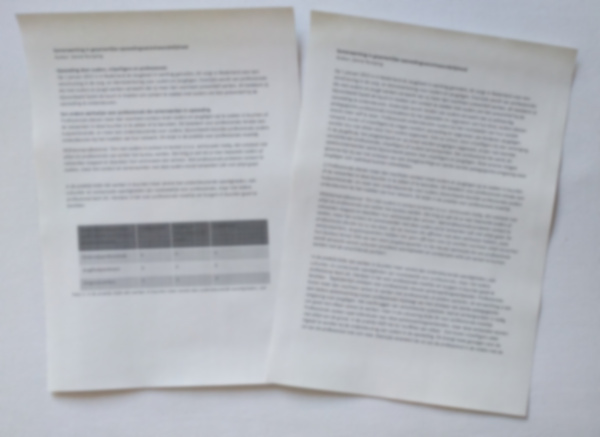It is half past seven already. You’ve just been sitting on your couch, going through the last work mails. And now you’re sitting behind your dinner table. This is the only place where you could stow away that pile of proposals, as thick as a brick. Let’s see if you can do another ten tonight, before you have to pick up your daughter from her hockey training. Ten proposals; will that make two or three grants?
One funding officer whom I worked with aptly summarized this situation: during the first look at your proposal, a reviewer is searching for reasons not to approve it. This can be a conscious effort, but also something he’s unaware of. The time pressure and the low average success rates are always in the back of his mind.
During that first impression, the extent to which your text is accessible makes all the difference. Even before any of its content is up for review. Take a look at this example, of which I deliberately made the content unreadable:

The text on the left has a clear layout and is navigable. You do not yet know what it will tell you, but you trust that you’ll learn that in a minute. You feel like starting the engine.
On the right the engine goes off immediately. What part should I focus on? You expect to get lost and end up driving in useless circles.
Short and well structured paragraphs are one of the ingredients of a navigable text. Parker Derrington explains this very well in one of his blogs:
- “Most of the people scoring your grant will speed-read your case for support. Speed-readers read the first line of every paragraph provided there is white space between them. The longer your paragraphs, the less you communicate with speed readers.
- Long paragraphs are usually very hard to digest. They are usually a sign that what you are writing is either very complex, or just a bit disorganised. The few readers who really want to read the detail in your case for support will find it hard.”
The structure of such a paragraph is always the same:
- Start with the main message of your paragraph. The most important point, the conclusion, the core; however you want to call it.
- Collect the arguments, examples, explanations that belong to that main message.
- Put those in your paragraph and connect them to the main message with signaling words (‘because’, ‘for example, ‘first’).
- Start a new paragraph as soon as you reached the following main message.
So next time, first put yourself in the shoes of your audience, who will journey through your proposal, and turn on the navigation for them. They will be grateful for it. And that is precisely what you want from someone who is to decide on your fate.
 Stijn is director, trainer and advisor at Analytic Storytelling. We help people to make content-driven stories. That is: clear and compelling communication on complex content.
Stijn is director, trainer and advisor at Analytic Storytelling. We help people to make content-driven stories. That is: clear and compelling communication on complex content.


